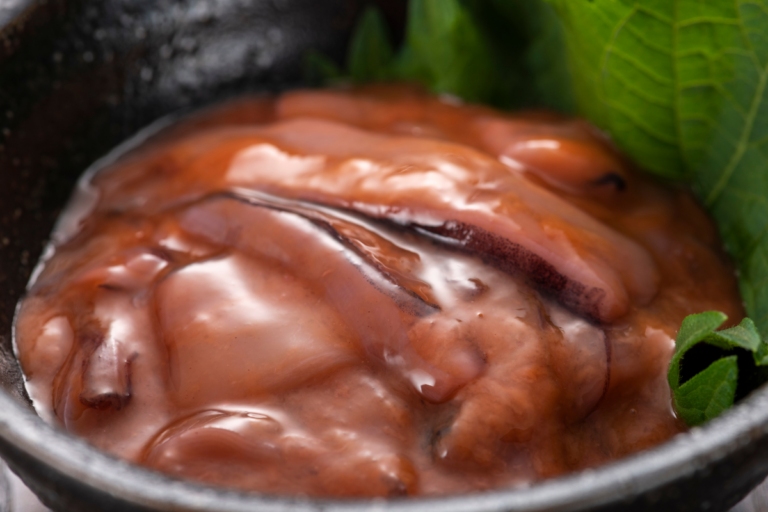Shiokara stands out as a delicacy that reflects the country’s diverse culinary history, renowned for its bold and distinct flavors. This fascinating dish comprises seafood chunks, and squid that undergo fermentation in a thick brown paste. The result is a robust blend cherished for its flavor, a signature feature of Japanese cooking.
Ingredients and Cooking Process
Typically centered around squid as the ingredient, Shiokara can also feature seafood varieties like fish or shellfish. The process entails slicing the seafood before fermenting it with a blend of its innards (internal organs) salt and sometimes a touch of malted rice or additional seasonings. This mixture is left to ferment over days to weeks to enhance and intensify the flavors.
Step by Step to Making Shiokara
Shiokara represents a fare crafted from fermented seafood, often squid, and can be easily prepared at home with patience and attentive care.
Here’s a detailed step-by-step guide on how to make Shiokara:
Ingredients:
- 1 squid (or any other seafood you prefer)
- 2 teaspoons of salt
- 1 teaspoon of sugar (if desired for flavor balance)
- 1 tablespoon of sake or mirin (for an extra flavor kick)
- Rice malt (optional to aid in fermentation)
Equipment:
- Sharp knife
- Cutting board
- Mixing bowl
- Glass jar or sealed container
- Clean kitchen cloth or paper towels
Instructions
Cleaning the Squid:
Start by cleaning the squid. Separate the head. Tentacles from the body keep the tentacles aside.
Carefully remove the innards from the squid’s body, making sure to preserve the ink sac if you plan to use it.
Rinse both the body and tentacles under running water to eliminate any remaining innards and sand. Pat them dry with a cloth or paper towel.
Preparing the Squid:
Cut the body into bite-sized strips.
Dice up the tentacles into pieces.
Creating the Fermentation Mixture:
Mix the squid innards with 2 teaspoons of salt, in a mixing bowl.
When preparing the dish remember to include sugar, sake or mirin, and a bit of rice malt. Make sure to mix everything well so that the squid is evenly coated with the salt and other seasonings.
Next, combine the sliced squid. Chopped tentacles, with the entrails in a bowl. Mix until the squid is thoroughly coated with the paste.
For fermentation, transfer the mixture into a glass jar or sealed container. Press down gently to remove any air bubbles. Seal tightly and store in a spot, for around 7 to 10 days; however, keep an eye on it as fermentation time can vary based on temperature and humidity levels.
After this fermentation period, check on your Shiokara. It should have developed a flavor and slightly thick texture by now. Taste an amount to determine if it suits your preference; if you want it stronger, let it ferment for a few more days.
Once your Shiokara reaches your desired taste, store it in the fridge. It will last for weeks while continuing to mature in flavor over time.
Here are some suggestions, for serving Shiokara:
Shiokara is best enjoyed in portions because of its taste.
You can serve it as a condiment with rice or as a side dish with sake.
It can also be used to season dishes or paired with crackers or bread for a touch.
Some tips to keep in mind:
Make sure your tools and surfaces are clean to prevent any bacteria.
Adjust the salt and sugar levels according to your taste preferences.
Feel free to experiment by adding seasonings like soy sauce or chili powder for variety.
Shiokara is a flavorful dish that captures the essence of culinary heritage. Enjoy the preparation process. Relish the flavors that develop through fermentation.
Flavor Description
Shiokara is not for those who shy away from flavors. It offers a taste along with a salty, slightly fishy flavor and a unique texture that combines creaminess with chewiness. The fermentation lends Shiokara its sharpness and depth of flavor, which may require an acquired taste for those to it.
Serving and Enjoyment
Traditionally, Shiokara is meant to be savored in amounts due to its flavor.
Shiokara is commonly served as a side dish or condiment and complements sake well and the alcohol helps to balance its flavor. Some people also enjoy it with rice to offset the taste of the dish.
Cultural Importance
In cuisine, Shiokara holds a position as a preserved food that highlights traditional preservation methods. It showcases Japan’s talent for creating dishes from ingredients through fermentation.
Contemporary Twists
While Shiokara remains a delicacy, modern adaptations and innovative uses have emerged. Chefs may incorporate it into dishes blending tradition with innovation to introduce its taste to a wider audience. Some upscale restaurants might even include Shiokara in their gourmet tasting menus, giving diners the chance to savor its flavor in a setting.
Shiokara transcends being a dish; it embodies the essence of culinary traditions. Its rich umami flavor, unique preparation, and cultural significance make it an intriguing topic for food enthusiasts and a memorable culinary experience for eaters.
What next:
- Crocodile Ice Cream: A Wild Adventure in Dessert-Making
- Pasta Carbonara- A Classic Italian Delight
- Japanese Miso Glazed Salmon – A Delicious Taste and Health
- Feijoada – A Taste of Brazil
- Bouillabaisse – The Legendary Fish Stew, from Marseille


